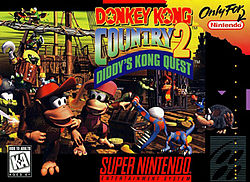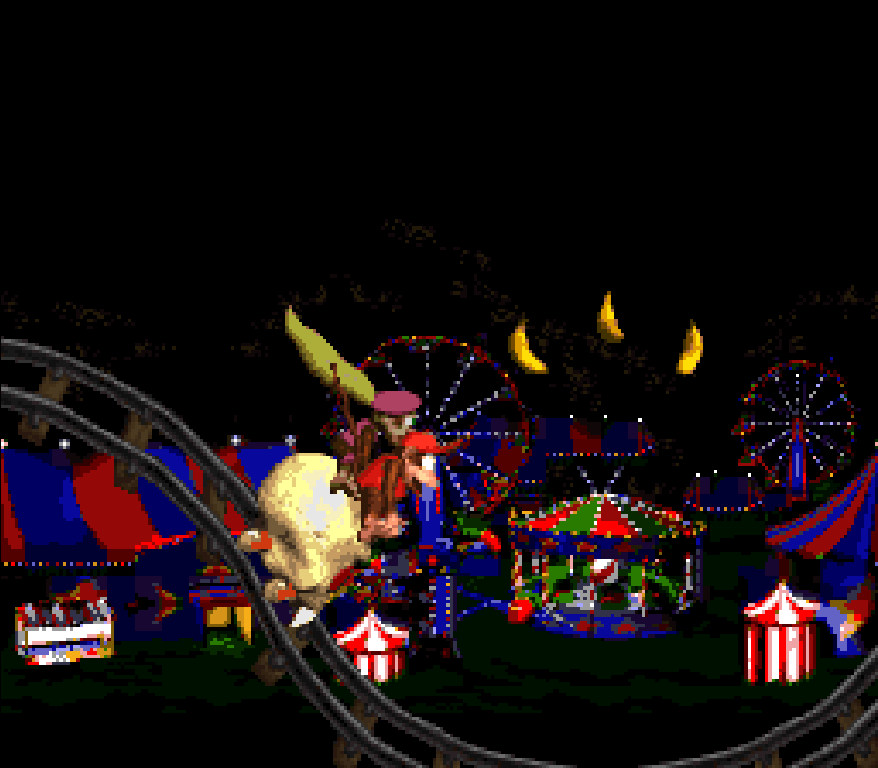

Title: |
|
Genre: |
|
|
Developer: |
|
|
Publisher: |
|
Release Date: |
|
On Wikipedia: |
|
System: |
|
Power Tip: |
|
This review was originally written December 22, 2013. It remains unaltered below, including the now-outdated paragraph (and overuse of "despite") of being able to buy it on Virtual Console. Unless you wanted to "stream" it to Nintendo Switch, it's ROM or bust now. (Box art is from Wikipedia).
Since the original Donkey Kong Country was a huge success, it was only natural to follow up with a sequel, released about a year after the original. The good news is, it's not a sequel that attempts to cash in on the original or just provides new levels, there's new mechanics and characters to really liven it up. The downside is that mechanics make things crazy difficult if you don't know what you're doing.
While the original DKC was quite playable--the first and second worlds were easy, while the third one started to ramp up in difficulty. In DKC 2, the first and second aren't all that difficult, but in the third world things start to get pretty difficult: better hope you have an emulator, because you'll be using freeze/defrost a lot. The bonus areas were pretty easy to find in DKC 1: you just had to know what you're doing. In DKC 2, you not only to know what you're doing, you have to look in all sorts of strange places, then hope your video game skills can push you through from there. Aforementioned new mechanics make these things difficult. You had also better hope you have both Kongs (Diddy and newcomer Dixie) with you, or life will be very difficult, even if you don't go for the bonuses.
Despite this, it is a good game and sold very well despite the sunsetting of the fourth generation of video games (the 16-bit systems: as of this writing, the 7th is coming to an end), and is another fine game in the SNES library. Despite the actual cartridge prices fetching a good amount on the used market, a copy can be acquired for about 800 Nintendo Points ($8 USD) for the Wii or Wii U.
The game introduces three types of coins, one of which is the DK Coin, a bonus coin (one in every level) that's simply a completion item, the Kremkoin, which allows entry to bonus levels later on, and a third coin. The last is Banana Coins. This is where the game just becomes so unfair. Sure, Banana Coins are relatively common and racking up a few isn't hard, but it's so unfair in that they're used: wants hints for a level? Banana Coins. Want to use the save point again after beating another level? Banana coins. Want to go to a different world? Banana coins.
These were all free in the original Donkey Kong Country, and you have to pay for the privilege now. Getting a game over (surprisingly easy to come across unless you grind the first level for extras) means you lose them all. These, of course, make Diddy's Kong Quest more of a chore than a benefit. While Kremkoins are pretty cool--they allow entry into the Lost World (analogous to the Star World in Super Mario World), Banana Coins are a waste of time. Just put banana bunches, which help you rack up your score to 100 bananas, getting you an extra life, instead of these things.
It's not a bad game by any means, the music, graphics, and all the other features are much improved. The game was also released for the Game Boy Advance. While it suffers the same washed-out effects as Donkey Kong Country for the GBA, it adds in new bonuses, but like the Game Boy Color version of Donkey Kong Country, the porting bonuses aren't worth the downgrades in everything else.
FINAL RATING: 
